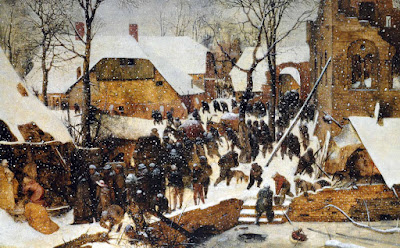We should all immediately switch to Instagram. But as with blogging, there’s a lot of unpredictability on the internet. There’s still plenty of room for intuition.
 |
|
Joan of Arc, 1879, Jules Bastien-Lepage, courtesy Metropolitan Museum of Art
|
Yesterday I had my left foot operated on, giving me a matched pair of incisions and some hope for less pain going into the summer.
 |
| Plastic bags, dethroned by art history. |
Measured week-to-week, however, art history is a slow starter. Those posts usually have the lowest immediate readership, even when they have much to say.
 |
|
Napoleon I on his Imperial Throne, 1806, Jean-Auguste-Dominique Ingres, courtesy, Musée de l’Armée, Paris
|
After more than a decade of blogging, I still see no discernible pattern for what will be popular in a post. That’s liberating. It means I can write about whatever I care about, rather than pitching content to some ‘expert’ idea of the public’s low taste.
A
surveytells us that new galleries are opening more slowly than they did a decade ago. This is part of a
general decline in entrepreneurship in the United States. It’s no surprise to those of us who worry about our battered small town Main Streets, but there’s good news in that same report.
It surveyed a group of high-net-worth individuals about their collecting habits. These are people with more than $1 million but less than $5 million in assets. The vast majority (89%) spent $50,000 a year or less on art and objects. That suggests they aren’t buying from tony Manhattan galleries, but from low- and mid-tier galleries. In other words, they’re buying works by people like you and me, in places like S. Thomaston, Camden and Ogunquit.
 |
|
The Adoration of the Magi in the Snow, 1567, Pieter Bruegel the Elder, courtesy Oskar Reinhart Foundation
|
Meanwhile, the online market for art and collectables
continues to grow, but at a slower pace. That makes sense as a market matures, and it’s nothing to worry about. More than half of online art buyers said they will buy more art online in 2018 than they did last year, according to the Online Art Trade Report.
Instagram has dethroned Facebook as the preferred means of online promotion. In 2016, galleries used the two platforms almost equally. Now only 31% of respondents prefer Facebook to the 62% who liked Instagram. Instagram is also the favored platform for collectors under 35, 79% of whom said they discover new artists on Instagram and 82% of whom said they use it to keep up with artists they like.
Going by the numbers, we should all immediately switch to Instagram. But just as with blogging, there’s a lot of unpredictability in sales. There’s still plenty of room for intuition.
It’s about time for you to consider your summer workshop plans. Join me on the American Eagle, at Acadia National Park, at Rye Art Center, or at Genesee Valley this summer.






